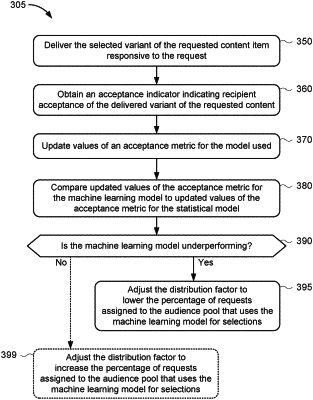| CPC G06N 20/00 (2019.01) [G06F 11/3495 (2013.01); G06N 7/00 (2013.01); G06Q 10/04 (2013.01); G06Q 30/0202 (2013.01)] | 18 Claims |

|
11. A non-transitory computer-readable medium storing instructions that cause a processor executing the instructions to:
receive a request from a client device for a content item;
assign the received request to an audience pool based on a distribution factor, the audience pool selected for assignment from a set of audience pools including a first audience pool that receives content parameterized using a machine learning model and a second audience pool that receives content parameterized using a statistical model, and the distribution factor causing the data processing system to direct a first percentage of incoming requests to the first audience pool and a second percentage of incoming requests to the second audience pool;
select a content variation responsive to the received request using a selection mode corresponding to the assigned audience pool, wherein
when the received request is assigned to the first audience pool, the selection mode causes use of the machine learning model to select the content variation from among a first plurality of candidate content variations, and
when the received request is assigned to the second audience pool, the selection mode causes use of the statistical model to select the content variation from among a second plurality of candidate content variations;
transmit the selected content variation to the client device;
obtain an acceptance indicator representing user interaction with the delivered content variation; and
update the distribution factor based on the obtained acceptance indicator and the assigned audience pool to direct different percentages of incoming requests to the first audience pool and the second audience pool and thereby balance content distribution based on performance of the machine learning model and the statistical model, wherein
when the received request is assigned to the first audience pool, the updated distribution factor increases a percentage of the incoming requests directed to the first audience pool and decreases a percentage of the incoming requests directed to the second audient pool, and
when the received request is assigned to the second audience pool, the updated distribution factor increases a percentage of the incoming requests directed to the second audience pool and decreases a percentage of the incoming requests directed to the first audient pool.
|